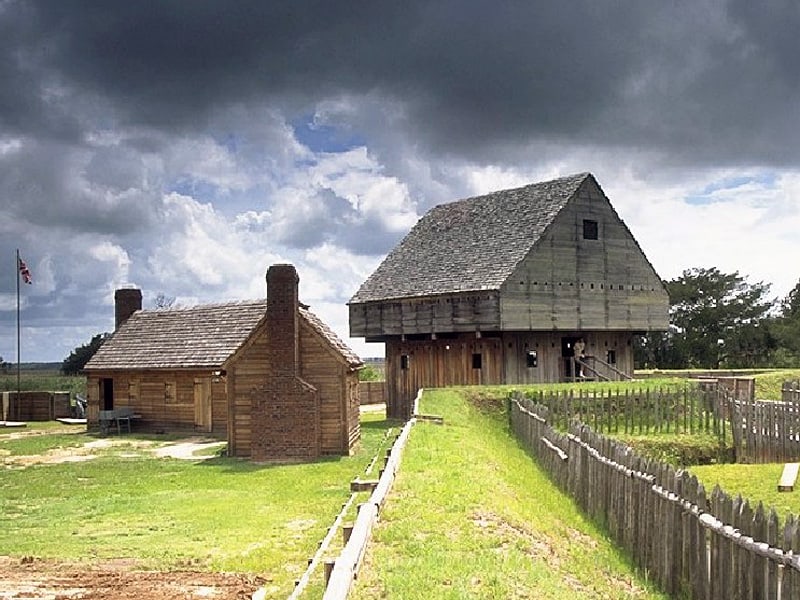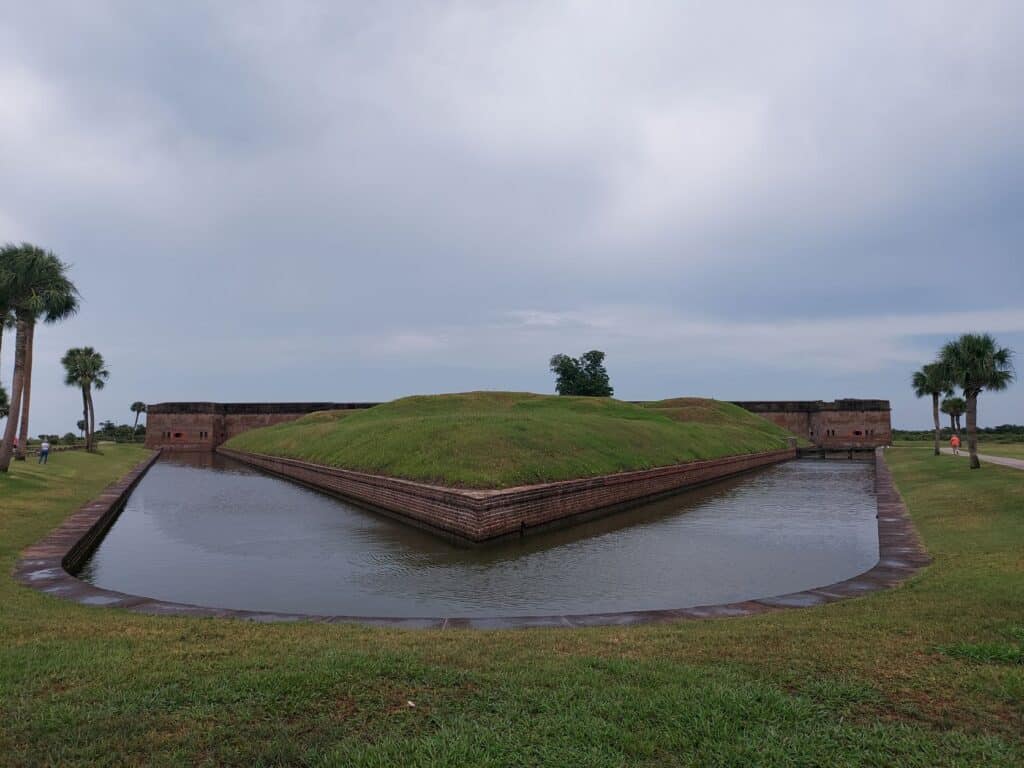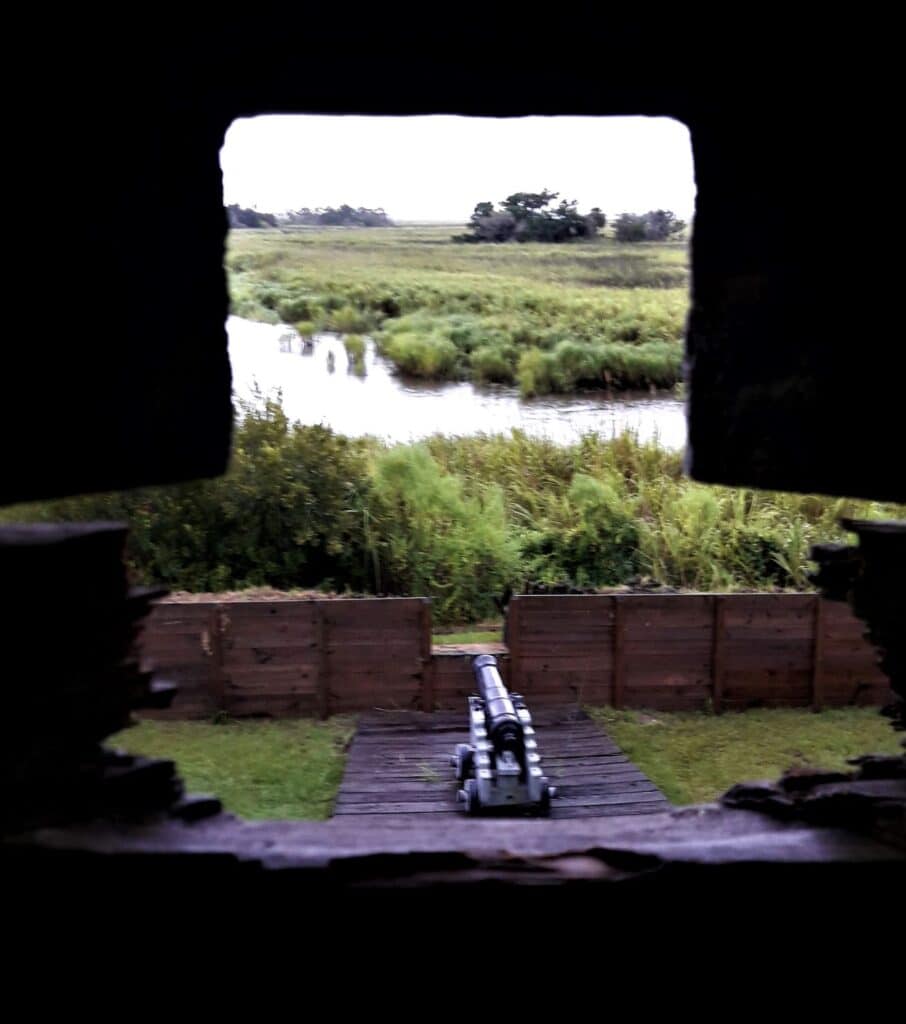Get Your Guard Up: Top 11 Historic Forts of the Southeast Coast
Did you ever create make-shift forts as a kid? Now you can explore the real thing! The Southeastern coast of the U.S. boasts a wealth of historic forts, remnants of the days when this territory was a battleground between the British, Spanish, and French, and later Union and Confederate forces. Today, these forts’ picturesque constructions and peaceful grounds reflect none of the bloodshed they once witnessed but instead provide informative, fun visits for the whole family. Read on to find which of these forts should be next on your list!
1. Castillo de San Marcos National Monument, St. Augustine, Florida

The Spanish-built Castillo de San Marcos, completed in 1695, is the oldest masonry fort in the continental U.S. One of only two forts in the world constructed of coquina (the other is Fort Matanzas also in St. Augustine), it has seen fifteen battles and two sieges – the 50-day siege of British Governor James Moore of Charleston in 1702 and General James Oglethorpe’s month-long siege in 1740 – without a defeat. Coquina proved to be a perfect building material, as it would not shatter; instead, it caused cannonballs either to bounce off the fort’s surface or to sink into the walls, “as though you would stick a knife into cheese,” the British lamented.
Peak into rooms restored to represent the Spanish guardroom, store room, and more, and visit on the weekend to witness cannon firing reenactments from the gun deck overlooking the beautiful Matanzas River.
Tour the fort with us on our Jewels of the South in 9 Days Tour!
2. Fort Caroline National Memorial, Jacksonville, Florida
When three hundred French colonists established a permanent settlement at Fort Caroline in 1564, the Spanish were worried this would disrupt their treasure ships’ long-used route from Central and South America along the Florida coast back to Spain. After Spaniard Pedro Menendez founded St. Augustine in September of 1565, he set off on his second mission: to attack Fort Caroline. He and his men easily overtook the fort, which was weakly guarded because most of the French troops under Jean Ribault had sailed south to attack St. Augustine. When the French ships were blown off course by a hurricane, Menendez located Ribault’s shipwrecked men, who pleaded for mercy. However, the Spaniard proclaimed them heretics and enemies of his king and slaughtered all who did not convert to the Catholic faith – 350 of them. The location of this massacre was later dubbed Matanzas (Slaughter).
Today at the park, discover history at the reconstructed fort, hike on nature trails, watch for dolphins in the St. Johns River, and more.
3. Fort King George Historic Site, Darien, Georgia

Fort King George of 1721 is the oldest British fort remaining on Georgia’s coast and was the southernmost outpost of the British Empire in North America at that time. By 1732, the British abandoned the fort due to the hardships of maintaining it against threats of Spanish and Native American attacks. Although it was manned for only six years (most of the troops were recalled from the fort in 1727), more than 140 officers and soldiers died here, mostly of diseases. Despite these setbacks, the fort was successful in establishing British control over what is now Georgia.
This fort has been beautifully reconstructed with an impressive three-story blockhouse surrounded by earthen ramparts, officers’ quarters, barracks, a guardhouse, moat, palisades, and a museum, all of which you may visit.
4. Fort Frederica National Monument, St. Simons Island, Georgia

Tabby Fort Frederica and its surrounding town were constructed under Georgia founder James Oglethorpe in 1736 to defend against the Spanish in Florida, who still claimed the coastal islands the British were now settling. The fort, armed with heavy cannon and enclosed by thick walls of earth and timber, was one of the strongest in the South, and the large town under its protection soon became one of the most prosperous in the Georgia colony. In 1742, the Spanish retaliated against Oglethorpe’s recent siege of St. Augustine by attacking St. Simons Island but saw defeat in a few bloody skirmishes. After these British victories, Frederica remained a flourishing town for another ten years, but the site’s no longer being needed for military purposes meant the community was not destined to survive either.
Visit the the original fort and barracks, and view the exposed foundations of many Frederica homes, most of which were destroyed by fire in 1758.
5. Fort Mose Historic State Park, St. Augustine, Florida
Fort Mose is the site of the first free black community in what is now the United States. Learning that if they could escape to Spanish Florida they would be set free in exchange for serving in the militia and adopting the Catholic faith, many enslaved Africans fled their British masters and crossed the border. By 1738, there were 100 of these former slaves in St. Augustine, and the Spanish joined them in building a strong fort of logs and earth north of the city to guard against British Fort Frederica. Just one year after Fort Mose was built, General James Oglethorpe attacked St. Augustine and overtook Fort Mose, which had been evacuated in anticipation of his arrival. In the early hours of June 26, 1740, Spanish and black troops launched a surprise attack on Fort Mose and succeeded in killing and capturing two-thirds of Oglethorpe’s army, which resulted in his lifting his siege.
Visit the museum, view interpretive displays, and stroll a board-walk leading through the beautiful marshes to an overlook where you can see the site of the original settlement.
6. Fort Matanzas National Monument, St. Augustine, Florida
After Oglethorpe’s unsuccessful siege of St. Augustine, the Spanish knew the British would be back and would most likely attempt to come through the unguarded inlet at Matanzas, fifteen miles south of town. They therefore built Fort Matanzas in 1740 to guard the southern approaches to St. Augustine and provide advanced warning in case of an attack from this direction. The fort saw only one battle when James Oglethorpe arrived off Matanzas Inlet in 1742 with twelve ships, but the Spanish soon drove off this scouting expedition with a single cannon shot.
Although the fort fell into disrepair by the time the U.S. gained possession of Florida in 1821 and played no part in the Civil War, it has since been restored. The ferry ride to Fort Matanzas showcases the beautiful natural scenery that surrounds the Matanzas River. You can explore the monument’s approximately 300 acres of Florida coastal environment containing dunes, marshes, and maritime forest.
7. Fort Moultrie, Sullivan’s Island, South Carolina
Fort Moultrie is the only unit in the National Park system where the entire 190 year history of the U.S. military’s coastal defense efforts can be explored. Its story begins in 1776 during the Revolutionary War, when Colonel William Moultrie and his patriot soldiers withstood the fire of British warships for nine hours in this unfinished palmetto log fort. Moultrie’s men returned cannon fire and eventually prevailed. After this, the fort became a landmark of the American Revolution and was named in honor of the brave colonel. Moultrie’s blue flag with a white crescent in the corner – with the addition of a palmetto tree – was adopted as South Carolina’s official state flag. Later, the fort served as a prison for the great Seminole chief Osceola (he died there and was buried just outside the gate), withstood nearly twenty months of Union bombardments in the Civil War along with Fort Sumter (see below), and remained an important U.S. military post until the end of World War II.
Today it preserves an array of fortifications ranging from the original brick walls of the 1809 reconstructed fort to concrete batteries and observation posts used through World War II.
8. Fort Jackson, Savannah, Georgia
Fort Jackson, just east of historic Savannah, is the oldest standing brick fort in Georgia. Built in 1808 of earth faced with brick and topped with a wooden gun platform, it was considered one of the strongest fortifications in the United States in its day and managed to survive both the War of 1812 and the Civil War. In this last war, the fort was taken by Sherman’s troops after they besieged Savannah in December, 1864. When the retreating Confederates saw the Union flag flying above the ramparts, they fired a few parting shots at the fort from their ironclad C.S.S. Savannah.
Drive just a few minutes outside downtown Savannah to experience daily cannon firings and exciting interactive programs for adults and kids alike.
Interested in a Savannah Walking Tour? Learn more here!
9. Fort Clinch State Park, Fernandina Beach, Florida

When the United States gained possession of Florida in 1821, the earthworks of an old Spanish fort remained on this site, but the Americans finally began work on Fort Clinch in 1847. When Florida seceded from the Union in January, 1861, the fort was still far from complete and did not possess a single cannon. Although by late 1861 an untrained battalion of artillery was stationed at the fort, General Robert E. Lee (then commanding the coastal defenses in Florida and Georgia) ordered the troops be withdrawn from the island. Union troops arrived as the last Confederate trains left Fernandina and sent the Rebels some parting shells. Fort Clinch was reclaimed by the U.S. Army in March of 1862.
Although the fort was never completed as planned, it has been well-restored, and visitors can view its walls, bastions, and guns and explore barracks, supply rooms, and more. Climb to the top of the complex for spectacular views of Cumberland Island, the mouth of the St. Marys River, and the Atlantic Ocean.
10. Fort Pulaski, Savannah, Georgia

How often do you get to see forts with moats? You can at Fort Pulaski! Realizing they needed stronger protection after the War of 1812, the Americans constructed forts up and down the East Coast. This fort, constructed on Cockspur Island at the mouth of the Savannah River in 1829, was considered to possess greater structural durability than earlier earthworks. That strength was put to the test in the Civil War, when the Union soldiers attacked in 1862. They bombarded the fort with a new technology the Confederates were not expecting – rifled cannons – which allowed them to shoot farther and more accurately than ever before. The Confederates, who thought they had been out of reach of the Union’s cannon fire from nearby Tybee Island, were proven wrong as the Union rocked the fort’s walls with cannon fire and came dangerously close to hitting its main powder magazine. To save his troops from a catastrophic end, the commander of the Confederate garrison, Colonel Olmstead, gave up the fort after just a 30-hour siege.
If you visit the fort today, you can still see the holes the Union cannons blasted in the walls and witness how hundreds of Confederate soldiers lived as they were imprisoned inside the fort they had so recently protected (you can even see their names they carved in the wall).
Interested in a Savannah Walking Tour? Learn more here!
11. Fort Sumter National Monument, Charleston, South Carolina

Take a scenic ferry ride to the fort where the Civil War began. After South Carolina declared its independence from the Union, American troops overtook the fort in December, 1860, causing the Confederates in nearby Fort Jackson to unleash a 34-hour straight bombardment on Sumter on April 12, 1861. The Union troops surrendered on April 13 and the Confederates proudly reoccupied Fort Sumter to the toasts and cheering of onlooking civilians in Charleston. For nearly two years, the Confederates held out against Union bombardments, even though the walls of the fort were reduced to rubble. They never surrendered the fort even when they were unable to return a single cannon shot against their attackers. However, they eventually did evacuate in February, 1865, as Sherman’s army marched north through South Carolina.
Even in its ruined state, Fort Sumter remained an important military installation in Charleston Harbor for many years afterwards. Wander the grounds to view Civil War cannonballs still lodged in the brick walls and the large nineteenth-century cannons on display.

Together, these forts’ intertwining histories illustrate the turmoil this region has witnessed as many countries battled for supremacy here. I hope this historic overview will spur you to get out and do some exploring, learning, and cannon firing in the American Southeast!
Interested in learning more about the history of the Coastal Southeast? Join a Cumberland Island or St. Marys Walking Tour!


